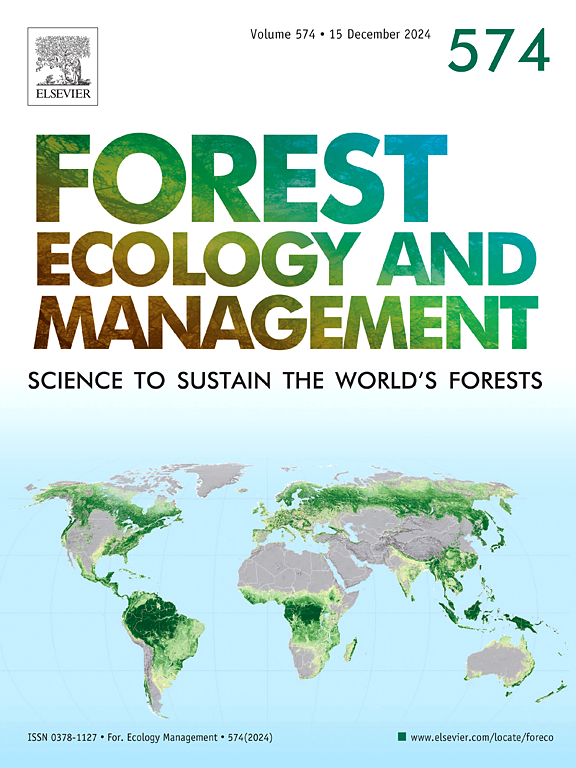复杂的生态路径驱动北方森林演替动态
IF 3.7
2区 农林科学
Q1 FORESTRY
引用次数: 0
摘要
随着全球环境变化,森林演替动态的普遍变化正在加速。然而,驱动演替转变的变量的相对重要性以及这些变量如何被气候变化改变仍然不清楚,部分原因是变量之间的生态路径可能很复杂。为了理清驱动连续灾难性扰动之间演替过渡的相互作用网络,我们利用了43年来反复测量的长期森林清查数据库,包括加拿大中部3465个北方森林样地,覆盖林龄1-261年。我们开发了一种混合分析方法,结合了增强回归树(BRT)和结构方程建模(SEM)。BRT评估了37个潜在影响变量中变量的相对重要性。扫描电镜检查了14个排名最高的(相对重要性>;1 %)驱动程序。总体而言,我们发现在平均间隔6.8年的连续普查中,向不同森林类型过渡的平均概率为4.6 %。通过对BRT和SEM中变量的相对重要性进行排序,我们发现,驱动演替转变的主要因素是群落内部同时发生的多种动态,而不是气候变化或场地和土壤条件。其中,最优势种的组成比例是最重要的驱动因素。当该样地从最小0.24增加到单一栽培(1.00)时,过渡的可能性从41.1 %下降到0.2 %,强调了单一物种主导的北方针叶林的缓慢演替过渡。我们的实证研究结果跨越了次生演替的过程,表明广泛预测的北方森林气候驱动的过渡可能比以前认为的依赖于环境和高度可变。本文章由计算机程序翻译,如有差异,请以英文原文为准。
Complex ecological pathways drive boreal forest successional dynamics
Pervasive shifts in forest successional dynamics are accelerating in response to global environmental change. However, the relative importance of variables driving successional transitions and how these are altered by climate change remain unclear, in part because the ecological pathways among variables can be complex. To untangle the web of interactions driving successional transitions between consecutive catastrophic disturbances, we utilized a long-term forest inventory database repeatedly measured over 43 years, encompassing 3465 boreal forest plots in central Canada and covering stand ages 1–261 years. We developed a hybrid analytical approach that combines boosted regression tree (BRT) and structural equation modelling (SEM). The BRT assessed the relative importance of variables among 37 potentially influential variables. The SEM examined multiple causal pathways of 14 top-ranking (relative importance > 1 %) drivers. Overall, we found an average 4.6 % probability of transitioning to a different forest type over consecutive censuses with a mean interval of 6.8 years. By ranking the relative importance of variables in BRT and SEM, we show that multiple, simultaneously occurring within-community dynamics, rather than climate variations or site and soil conditions, primarily drive successional transitions. In particular, the compositional proportion of the most dominant species was the most influential driver. As it increased from a minimum of 0.24 to monoculture (1.00) in the plot, the likelihood of transition decreased from 41.1 % to 0.2 %, emphasizing slow successional transitions in the mono-species dominated boreal forest. Our empirical findings, spanning the course of secondary succession, suggest that the widely predicted climate-driven transitions in boreal forests may be context-dependent and highly variable than previously thought.
求助全文
通过发布文献求助,成功后即可免费获取论文全文。
去求助
来源期刊

Forest Ecology and Management
农林科学-林学
CiteScore
7.50
自引率
10.80%
发文量
665
审稿时长
39 days
期刊介绍:
Forest Ecology and Management publishes scientific articles linking forest ecology with forest management, focusing on the application of biological, ecological and social knowledge to the management and conservation of plantations and natural forests. The scope of the journal includes all forest ecosystems of the world.
A peer-review process ensures the quality and international interest of the manuscripts accepted for publication. The journal encourages communication between scientists in disparate fields who share a common interest in ecology and forest management, bridging the gap between research workers and forest managers.
We encourage submission of papers that will have the strongest interest and value to the Journal''s international readership. Some key features of papers with strong interest include:
1. Clear connections between the ecology and management of forests;
2. Novel ideas or approaches to important challenges in forest ecology and management;
3. Studies that address a population of interest beyond the scale of single research sites, Three key points in the design of forest experiments, Forest Ecology and Management 255 (2008) 2022-2023);
4. Review Articles on timely, important topics. Authors are welcome to contact one of the editors to discuss the suitability of a potential review manuscript.
The Journal encourages proposals for special issues examining important areas of forest ecology and management. Potential guest editors should contact any of the Editors to begin discussions about topics, potential papers, and other details.
 求助内容:
求助内容: 应助结果提醒方式:
应助结果提醒方式:


